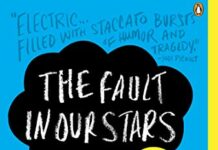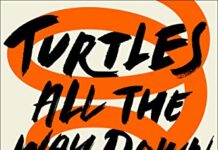
Ebook Info
- Published: 2008
- Number of pages: 227 pages
- Format: MOBI
- File Size: 0.50 MB
- Authors: John Green
Description
The award-winning, genre-defining debut from John Green, the #1 bestselling author of The Anthropocene Reviewed and The Fault in Our StarsWinner of the Michael L. Printz Award • A Los Angeles Times Book Prize Finalist • A New York Times Bestseller • A USA Today Bestseller • NPR’s Top Ten Best-Ever Teen Novels • TIME magazine’s 100 Best Young Adult Novels of All Time • A PBS Great American Read Selection • Millions of copies sold! First drink. First prank. First friend. First love. Last words. Miles Halter is fascinated by famous last words—and tired of his safe life at home. He leaves for boarding school to seek what the dying poet François Rabelais called the “Great Perhaps.” Much awaits Miles at Culver Creek, including Alaska Young, who will pull Miles into her labyrinth and catapult him into the Great Perhaps. Looking for Alaska brilliantly chronicles the indelible impact one life can have on another. A modern classic, this stunning debut marked #1 bestselling author John Green’s arrival as a groundbreaking new voice in contemporary fiction. Newly updated edition includes a brand-new Readers’ Guide featuring a Q&A with author John Green
User’s Reviews
Reviews from Amazon users which were colected at the time this book was published on the website:
⭐One warning, if you suffer from depression and/or suicidal thoughts, this book may not be a good story to read. The depth of this book, in terms of looking at depression, suicide and loss, really surprised me. I have been trying to find books to help me understand several people I have personally known well, two of whom committed suicide, and my oldest brother who drank himself to death. I have found it really difficult, but helpful, to find books that might help me get my head around the fact that no matter how well we think we know someone, or want to help them, mental health disorders, depression and suicide have sides to them that make it difficult to actually understand the depth of their problem. So, after reading other books like Thirteen Reasons Why, All the Bright Places, The Perks of Being a Wallflower, and others, this book Looking For Alaska had so many poignant points that I found more helpful than the other books.First off, John Green’s characters were well constructed in terms of the tight knit circle of freinds who were there for each other, going through many of the issues of belonging, where do I fit in, etc, of the teenage angst many go through. Much of this book made me think of the more recent pain my daughter went through in high school, which was brutal at times. But, these are timeless issues, and it was easy to think back to my own issues many years ago. Alaska Young, the main character, was very well written. She was beautiful, funny, smart, well liked (to a point), but there were moody, unpredictable sides of her that were hard to understand (which is very true of depression and mental healt issues). Our storyteller Pudge, is smitten with her, as most guys her age would be. And they become best friends. But, there is The Colonel, Pudge’s roommate, funny, smart, with a huge chip on his shoulder for rich and priveledged kids their age. He is likeable and very smart, as well. He has also known Alaska for several years and knows how moody and capricious she can be. Other members of their group take in Takumi and Lara. As the story shows the fitting in issues, Alaska is a character it’s so easy to like. She’s full of life, brightens up the room with her smile and coquettish behavior, but, what’s also likeable, she is always clear with anyone that she has a boyfriend she adores.Two main themes throughout the narrative is that Pudge is driven by a quote he read, that is now directing his life, which states“I go seek a Great Perhaps.” He is looking for more. Alaska is obsessed with something she read in a novel talking about the struggle of life, which states, “How will I ever get out of this labyrinth?” As the story continues, you realize that Alaska flies off the handle, suddenly withdraws from everyone, and no one can understand this side of her. Most of all Pudge. One of Pudge’s and Alaska’s classes together is religion and philosophy. This is a great tool used by the the author to confront many of the issues unfolding.To get to the point, as you see Alaska boldly act brazenly at times, impetuously, and take blame before a panel that caught them all smoking, and other things along these lines, her behavior seems at times self destructive. She drinks a lot and even makes a comment to her friends, when asked why she chain smokes at times, inhaling so hard, she says she does it to kill herself. Green does a great job making her complex in ways that people with mental health issues are really complex. They can be hard to understand and unpredictable. And this is Alaska.There is a point in the book, when they are all drinking heavily, and Alaska suggest they play a drinking game and tell their best day ever, and their worst day ever. They’re all very drunk. And Alaska admits that when she was a little girl, her mother died of an aneurysm right in front of her, and she had didn’t know what to do, but just sat with her waiting for her to wake up. And when her father came home he made it clear that it was her fault her mother died. Why didn’t she call 911? And so on. We find out Alaska is a tortured person and can’t break free of it. Needless to say, later in the story, while all drinking, Alaska gets a phone call in the middle of the night from her boyfriend. No one knows what’s said, but she is horribly distraught and crying uncontrollable, and she has to leave, has to get out, and she tears off and she dies that night. And the big question is was it suicide? And of course, her friends helped her leave because she “had to” so badly. And now they are tortured by the reality that they could have stopped her.The kinds of questioning and guilt Green discribes is so astute and tears at your heart if you have ever suffered real loss of a loved one, especially if it was from suicide or under tragic circumstances. The Religion class resurfaces as it turns out Alaska had written her final essay paper on “How will we ever get out of this labyrinth of suffering?” The teacher, who admired Alaska, and in helping students cope, he puts her question on the blackboard, and he turns her question into an essay question for them final exam for everyone to grapple with. This was a clever device in the story as Pudge comes to grips, and we as the readers try to understand the seemingly senseless loss. The Pudge’s essay answer is a wonderful wrap up to the story. He uses things they learned from Buddhism to state things like, all things that come together will fall apart, and all things are interconnected, so that the loss of Alaska, she isn’t truly lost. “Maybe she was just matter, and matter gets recycled.” But, Pudge also realizes that even as sad and tragic as Alaska’s life was, it didn’t have to end that way. Pudge writes, “Awful things are survivable,” and he wishes he could have told Alaska that. And that we are as indestructible as we believe ourselves to be.
⭐I initially picked this book to read for a literature class I am taking for a module on the censorship and banning of books for children and young adults. Having absolutely loved The Fault in Our Stars, when I saw this John Green novel on the ALA’s list of most frequently banned books in the 21st century, I jumped at it. The grounds for its censorship has been the presence of profanity, underage drinking and smoking, drug use, and sexual content. It is true, there is all of that, but presented in a realistic, true-to-life way. I am staunchly opposed to censorship and banning and this is a book that I not only don’t believe deserves to be banned, but it is one that I have made a “must read” for my own kids.The novel takes place within the Culver Creek Preparatory High School near Birmingham, Alabama. Miles “Pudge” Halter is the new student, obsessed with the last words of famous people. He has transferred to Culver Creek in the hopes that he can find his own “Great Perhaps,” an idea that has come from the last words of François Rabelais, “I go to seek a Great Perhaps.” At his last school, Miles was a bit socially awkward, more obsessed with reading biographies than with socializing with friends, and he wants to start fresh at Culver Creek. The first person he meets is Chip “The Colonel” Martin, his new roommate who introduces Miles to his own best friends. Takumi Hikohito is obsessed with hip hop and rapping and Alaska Young is a beautiful girl, although emotionally rather unstable, for whom Miles immediately falls.In many ways, Alaska is the glue that holds the group of friends together. She is beautiful and intelligent and fun to be with and very enigmatic. Although we see different parts of her throughout the book, we, as readers, never really know her any more than her friends do. Even at the end, there are questions that leave you angsty and emotional. Her story is her own and threads of it run through the stories of all of her friends. She is irrevocably a part of their own histories in a myriad of ways.More than anything, it is a story of coming of age, with all of the pain and angst that goes along with it. There are beautiful moments, funny moments heart wrenching moments, touching moments. There are moments of laughter and moments of sadness. It is an absolutely beautiful story.One of the things I really enjoyed about the book was its structure. It is created in two parts, “Before” and “After,” leading us to and from a pivotal point that I won’t describe. The chapters underscored that concept, marking time like “forty-five days before.” You know something is going to happen, but you have no idea what it is.My Recommendation: I think that this is a beautiful book that touches on real situations in ways that are both touching and tragic.
⭐Amid all the sadness and loss and wasted life within this story, there was occasional rollicking humor, and frequently a wistful sweetness that even tragedy could not destroy. I was less interested in Alaska’s personality than in those of her friends Miles and the Colonel; Alaska was a psychological whirlwind who never really grew, while Miles and the Colonel struggled hard to figure out who she was and who they were. Pranks and hijinks aside, it was their struggles that made Looking for Alaska a riveting story. My two favorite lines, both near the book’s end, were “we had to forgive to survive in the labyrinth,” and “If only we could see the endless string of consequences that result from our smallest actions.” Ultimately the narrator, Miles, discovered that forgiveness gave him enough hope to move forward.
⭐I got this book because I’d read Green’s other books. I love that he creates interesting, strong, female characters. I knew nothing of it’s plot or tone or anything. I entered the labyrinth unencumbered with expectation. At first, I was thinking, oh Lord, a depressed lonely kid, and an angry roommate (I pictured the Colonel as Sean Austin.) But, deeper into the labyrinth I went on my quest to see what was the point of this story. The big event was a surprise. I, too, was desperate to know the answers to the W questions. So much so, I devoured the book in one sitting. Actually didn’t go to work (I wasn’t required to go in, but seeing as my workload has just increased, probably should have…ah those tiny decisions…) because I was invested in knowing. It’s a fault of mine. I hate not knowing when I could know. And, it was totally worth it.
⭐I bought this book for my daughter, she is 14. I was really very disappointed when she said she was enjoying the book but there were some descriptive bits discussing a porn movie and then descriptive sexual content. I really wish books aimed at young people would disclose if there is content like this….some of us what to keep our children from being exposed too young to themes that for adults. She has decided to forego reading the rest, even though she was enjoying it, because she doesn’t want to read those parts. I wish writers for teens would follow writer’s life Stephenie Meyer, who wrote her books for young people to enjoy – and they did! – but left out descriptive scenes to protect young minds.
⭐John Green was already one of my favourite authors before reading this book. I had read just The Fault in Our Stars by him yet I liked him. His writing is so raw and real. When I finished this book, I was not sure how to write its review. Whether to be happy or to be sad. I was conflicted literally because of the ending? I am not sure if it was meant to end like that or it was on purpose? But yet, I love the overall book. But here, I should definitely mention that I would have enjoyed it way more if I would have read it like 3-4 years back.Miles Halter is the main protagonist of the story who lives in Florida. He is not a social person and is in search of his “Great Perhaps”. So Miles decides to attend the Culver Creek Boarding School in Alabama to start a fresh life. There he makes his first friend Chip, known as “the Colonel” by all. He nicknamed Miles as “Pudge” and called him with the same name throughout the book. The Colonel introduces him to his friend, Alaska, who was a fierce and mysterious girl. Miles instantly falls in love with her. All of them are then involves in various pranks and mishappenings and then BAM! There is the unexpected mid-way surprise. I am not telling what that middle thing is (for the sake of spoilers) but that event divides the book into two part. One Before and one After that event.The Before part is filled with a lot of high school events, the building of relations, the pranks that student plays and all. Yes, the typical high-school environment has been explained. The After part describes what happens after that tragic event, how the truth unfolds and how the lives of everyone involved changes. The Before part is kind of happier while the After is the one with lots of sorrow and heartbreak.The best thing about Looking for Alaska is that it doesn’t feel like it’s a debut novel of John Green. It has so much more hidden things to say then the words can explain. John green has definitely shown his best raw talent in this and proving that you can literally emerge like a different person after you finish his book. It is a gripping tale. It is not a typical boy-meets-girl-falls-in-love-then-separate kind of story. It is a tale of true friendship, the effect of love, the longing for survival, the void in a relationship.The story is more about Miles then about Alaska (as the title may confuse). The center point for both of them is looking for “labyrinth”. I actually didn’t know about this word at the beginning but then it was used so many times in the book that it made itself clear. A unique thing that John Green has put as the hobby of Miles is “remembering the last lines of famous persons”. I was like, why would anyone like to remember that? But surely, after reading many such sentences in the book it surely made me interested in those last lines.”Thomas Edison’s last words were “It’s very beautiful over there”. I don’t know where there is, but I believe it’s somewhere, and I hope it’s beautiful.” “The only problem that I had with this story was its ending. I felt like cheated. No seriously I wanted it to end correctly and to know the truth. But I think, the valid point in its favour can be that John wanted to think the readers about it?All the characters that are mentioned feel like in real life. There are no cheesy ones, not even Alaska (though girls are generally shown as cheesy). I liked how the character of Alaska was made mysterious. And the fact is we often come across such characters in our lives too, who are mysterious in their own ways. The writing was typical John Green style – easy and flowing. And the best things is the beautiful quotes that he writes, which always make me love his work more.”I may die young, but at least I’ll die smart. “This story clearly reminded me of many things that were long forgotten. One such thing is the use of “Yellow Pages”. DO you remember this service? I used to use it like 6-7 years ago? There were other events too which clearly reminded that I am reading it little bit late Looking for Alaska is another fantastic book by John Green. It is funny and heartbreaking at the same time. This gives you new directions and point of thinking. If you love John Green then you should definitely read this.”If people were rain, I was drizzle and she was a hurricane.”
⭐Out of all the John Green books that I’ve read, I’ve found this one simply the best. It’s better than Fault in our stars for sure. But it’s much more different from that. The story is amazing. The characters are relatable will stay with you for life. It will bring back your days of high school (if you’ve passed out) or shine your days if you’re still in high school. Stop reading reviews. GO READ IT.
⭐A quick easy YA read. The book follows Miles, a quiet guy who goes to boarding school looking for a great perhaps. He makes new friends, enjoys life and feels like he’s found what he was looking for.The book doesn’t have chapter numbers which really bothered me, the chapter titles are a countdown to a date or event though which I found intriguing. The characters were well described, not so much their features but their personalities. The best thing about this book is how real it is. The characters, conversations, experiences were all fitting of a group of 16-17 years olds at schools. The thoughts, feelings and reactions were very realistic and I bought into the story very easily because if it and became invested. There was only once when a teachers reaction to a prank didn’t quite ring true and it stood out because it was the only part of the book that didn’t feel genuine.Overall a great book which would be especially enjoyed by fans of YA coming of age stories. Will certainly be reading more by this author
⭐If you’ve watched the TV series of this story, and loved it, then you’ll find the book a little disappointing in comparison. Unlike most stories that are turned to TV or Film, where the book often offers more detail and insight in to the story, this is the other way around. Sure, the story is there in the book, with a few minor differences to the TV show, but when they made it for TV, they did an excellent job of fleshing out the other characters, such as the teachers and parents to bring more of a background and story to them as well as the relationship between all characters. The book itself would have been better with twice the number of pages and more effort put in to the detail; overall it seemed a little rushed, especially when you see what the screenwriters managed to do with it. The General in His Labyrinth by Gabriel Garcia Marquez, which is Alaska’s favourite book, is worth getting and reading, albeit just as a side interest, though it’s certainly more of an adult literature, and can help get an idea of where they were going with Alaska’s mental state in relation to it. The authorship of Looking for Alaska certainly shows that it’s not a seasoned author that has written it, and there’s definitely room for improvement. However, saying that, it’s certainly worth a read, just for comparison to the TV show, and for the final detail of Miles’ end of term paper, which is the only bit that is perhaps not focused on as much on the TV as it was in the book.
Keywords
Free Download Looking for Alaska in MOBI format
Looking for Alaska MOBI Free Download
Download Looking for Alaska 2008 MOBI Free
Looking for Alaska 2008 MOBI Free Download
Download Looking for Alaska MOBI
Free Download Ebook Looking for Alaska




